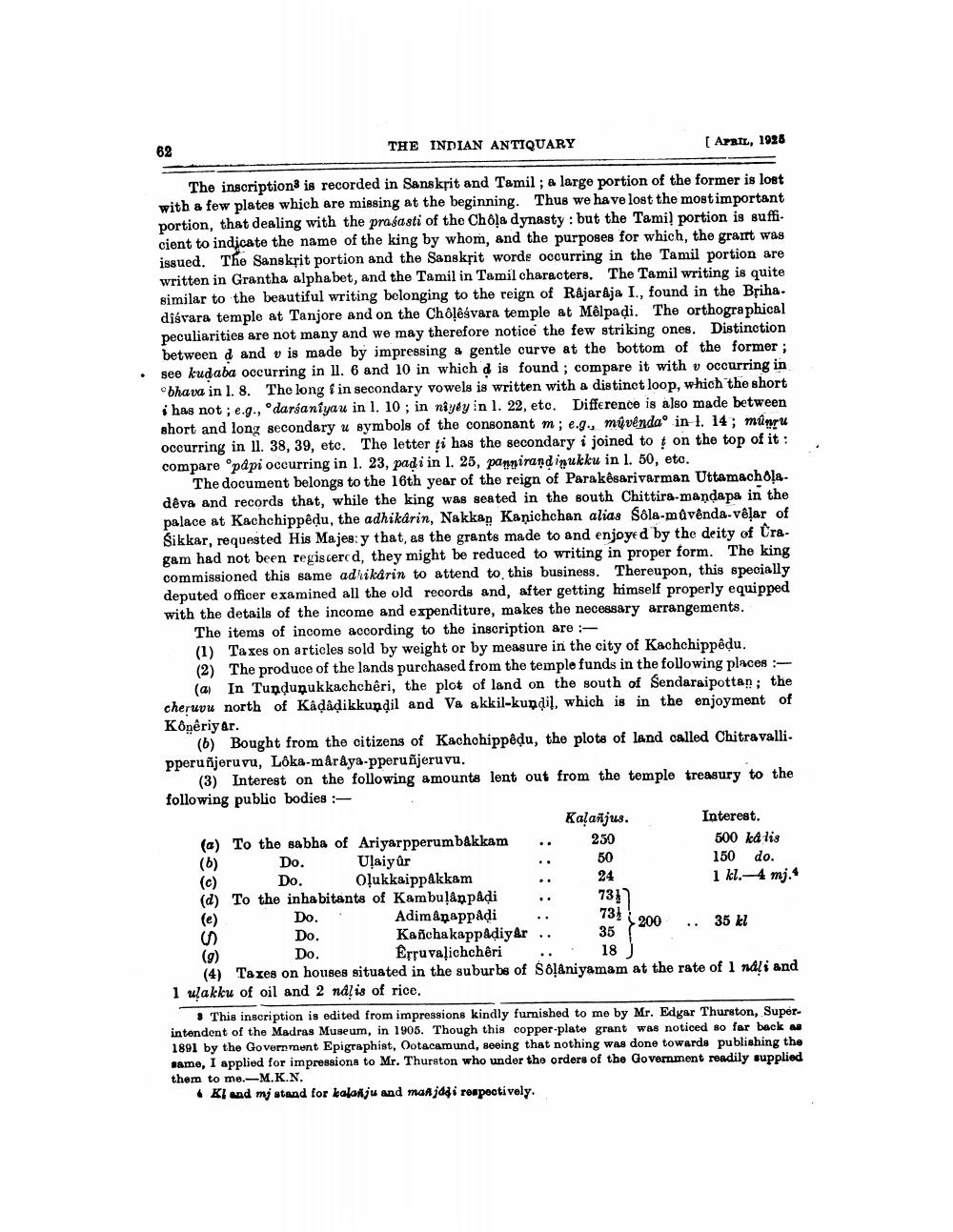________________
THE INDIAN ANTIQUARY
(Arsiz, 1928
The inscription is recorded in Sanskrit and Tamil; a large portion of the former is lost with a few plates which are missing at the beginning. Thus we have lost the most important portion, that dealing with the pragasti of the Chola dynasty : but the Tamil portion is suffi. cient to indicate the name of the king by whom, and the purposes for which, the grant was issued. The Sanskrit portion and the Sanskrit worde occurring in the Tamil portion are written in Grantha alphabet, and the Tamil in Tamil characters. The Tamil writing is quite similar to the beautiful writing belonging to the reign of Rajaraja I., found in the Briha. disvara temple at Tanjore and on the Cholêsvara temple at Mêlpadi. The orthographical peculiarities are not many and we may therefore notice the few striking ones. Distinction between d and v is made by impressing a gentle curve at the bottom of the former ; see kudaba occurring in 11. 6 and 10 in which d is found ; compare it with v occurring in bhava in l. 8. The long i in secondary vowels is written with a distinct loop, which the short i has not; e.g., darśaniyau in l. 10; in niyey in l. 22, etc. Difference is also made between short and long secondary u symbols of the consonant m; e.g., mûvéndao in 1. 14; mũnru occurring in 11. 38, 39, etc. The letter ti has the secondary i joined to on the top of it: compare opápi occurring in l. 23, padi in l. 25, pannirandinukku in l. 50, etc.
The document belongs to the 16th year of the reign of Parakêsarivarman Uttamachoļadêva and records that, while the king was seated in the south Chittira-mandapa in the palace at Kachchippedu, the adhikarin, Nakkan Kanichchan alias Sole-mûvênda-vêlar of Sikkar, requested His Majes: y that, as the grants made to and enjoyed by the deity of Cragam had not been registered, they might be reduced to writing in proper form. The king commissioned this same adhikarin to attend to this business. Thereupon, this specially deputed officer examined all the old records and, after getting himself properly equipped with the details of the income and expenditure, makes the necessary arrangements.
The items of income according to the inscription are:(1) Taxes on articles sold by weight or by measure in the city of Kachchippêdu. (2) The produce of the lands purchased from the temple funds in the following places :
(a) In Tundunukkachchêri, the plot of land on the south of Sendaraipottan: the cheruvu north of Kadaạikkundil and Va akkil-kundil, which is in the enjoyment of Köşêriyar.
(6) Bought from the citizens of Kachchippêdu, the plots of land called Chitravalli. pperuñjeruvu, Loka-maraya-pperuñjeruvu.
(3) Interest on the following amounts lent out from the temple treasury to the following public bodies :
Kaļañjus.
Interest. (a) To the sabha of Ariyarpperumbakkam
250
500 ka lis (6) Do. Uļaiyûr
50
150 do. (c) Do. Olukkaippakkam
1 kl.-4 mj.4 (d) To the inhabitants of Kambuļånpadi Do.
Adim Anappadi Do.
200 .. 35 kl Kanchakappadiyar ..
35 Do.
Ersuvaļichchêri .. 18 (4) Taxes on houses situated in the suburbs of Sôļâniyamam at the rate of 1 nali and 1 ulakku of oil and 2 ndl is of rice.
24 731
This inscription is edited from impressions kindly furnished to me by Mr. Edgar Thurston, Superintendent of the Madras Museum, in 1905. Though this copper-plate grant was noticed so far back as 1891 by the Government Epigraphist, Ootacamund, seeing that nothing was done towarde publishing the same, I applied for impressions to Mr. Thurston who under the orders of the Government readily supplied them to me.-M.K.N.
4 Kl and mj stand for kalalju and manjadi respectively.




